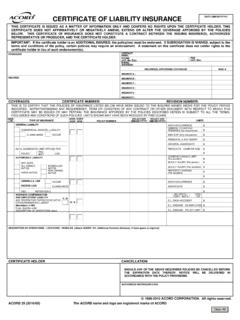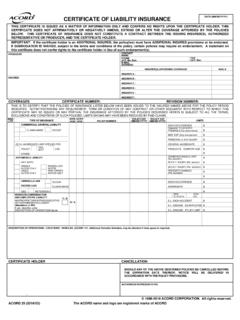Transcription of Directors & Officers Liability Insurance and …
1 Directors and OfficersLiability Insuranceand IndemnificationSecond EditionJohn A. Edie and Jane C. Nober Directors and OfficersLiability Insuranceand IndemnificationSecond EditionJohn A. Edie and Jane C. Nober iiVISIONThe Council s vision for the field is ofA vibrant, growing and responsible philanthropic sector that advances the common see ourselves as part of a broad philanthropic community that will contribute to this aim to be an important leader in reaching the Council on Foundations provides the opportunity, leadership and tools needed by philanthropicorganizations to expand, enhance and sustain their ability to advance the common carry out this mission, we will be a membership organization with effective and diverse leadership that helps the field be larger, more effective, more responsible and more common goodwe mean the sum total of conditions that enable community members to achievements have a shared nature that goes beyond individual philanthropic organizationswe mean any vehicle that brings people together to enhance the effectiveness, impact and leverage of their philanthropy.
2 This includes private and communityfoundations, corporate foundations and giving programs, operating foundations, and public foundations, as well as emerging giving and grantmaking mechanisms involving collective participation. STATEMENT OFINCLUSIVENESSThe Council on Foundations was formed to promote responsible and effective philanthropy. Themission requires a commitment to inclusiveness as a fundamental operating principle and calls foran active and ongoing process that affirms human diversity in its many forms, encompassing butnot limited to ethnicity, race, gender, sexual orientation, economic circumstance, disability and philosophy. We seek diversity in order to ensure that a range of perspectives, opinions and experiences are recognized and acted upon in achieving the Council s mission. The Council alsoasks members to make a similar commitment to inclusiveness in order to better enhance their abilities to contribute to the common good of our changing society.
3 2007 Council on Foundations, Inc. All rights L Street, NW, Suite 300 Washington, DC 20036-5168 202/466-6512 Fax 202/785-3926 I:What Are the Real Risks?..3 Question 1:What is general Liability Insurance ?..3 Question 2:What potential risks are not covered by general Liability Insurance ?..3 Question 3:When it comes to Liability , is there any differencebetween being a trustee and being a director?..5 Question 4:What are Chapter 42 taxes and penalties?..5 Question 5:How many foundations are audited each year and how much do foundations pay in penalty taxes?..6 Question 6:Are there fines or penalty taxes that can apply to public charities such as community foundations?..6 Question 7:Are there other IRC violations that can subject a grantmaker to penalties?..6 Question 8:What are some examples of actual lawsuits or other actions against foundations and/or foundation managers?..7 Part 9:What is indemnification ?..11 Question 10:What risks can be covered by indemnification and what risks cannot?
4 12 Question 11:How does a foundation provide for indemnification ?..13 Question 12:Don t state laws make Directors of nonprofit organizations immune from Liability ?..14 Table of ContentsiiiPart III: Directors and Officers Liability 13:What is D&O Insurance ?..15 Question 14:Who is covered by D&0 Insurance ?..15 Question 15:Which areas are covered by D&O Insurance and which are not? How does D&O Insurance differ from indemnification ?..16 Question 16:If actual lawsuits are so rare, is D&O Insurance really necessary?..17 Question 17:How should a foundation decide whether to obtain D&O Insurance ?..17 Question 18:Why not simply provide for each director to be covered by his or her personal umbrella policy?..18 Question 19:How much D&O coverage is needed?..18 Question 20:What are the important provisions to look for in a good D&O policy? What are some of the pitfalls toavoid?..18 Question 21:Do D&O policies cover the Chapter 42 penalties that private foundation managers can be subject to?
5 20 Part IV:Correct Tax Treatment of Insurance 22:If a private foundation or public charity purchases D&O Insurance for a manager, does the manager have to include the amount of the premium in his or her taxable income?..23 Question 23:If a private foundation or public charity makes an indemnification payment to a manager, must the manager include the payment in his or her taxable income?..23 Question 24:Must indemnification payments and/or payments for D&O Insurance be included in total compensation for the purpose of determining whether a private foundation manager s compensation is reasonable?..23 Question 25:The Intermediate Sanctions (Tax Code Section 4958)that apply to public charities also prohibit excessivecompensation for charity managers. Must managersinclude the allocable portion of D&O premiums or indemnification payments made to or for them as part of their compensation package?..25 Part V:How to Minimize Your RisksQuestion 26:What steps can a foundation take to reduce the potential Liability of its board members?
6 Boards of Directors , trustees and foundation managers, there are fewareas of operation that cause more confusion and uncertainty thanindemnification and the purchase of Directors and Officers (D&O) lia-bility Insurance . And it is no wonder. Mixing the often impenetrablestatutory language of the Internal Revenue Code with the highlyrefined wording of Insurance policies creates fertile ground for confusion. Tomake matters worse, the rules are not static. State laws change, Treasury regula-tions are revised and Insurance policy language is frequently the years, members of the Council on Foundations have raised a steadystream of questions about potential Liability , indemnification and the purchase ofD&O Insurance . These questions have taken on more urgency as the increasedscrutiny of Directors of for-profit corporations has led many state regulators tofocus their attention on the behavior of nonprofit officials as well. Foundationmanagers increasingly recognize that their leadership roles come with potentialrisks, and they want to know how to protect themselves and the foundationsthey serve.
7 This paper seeks to address these concerns. It brings together backgroundinformation on relevant state laws, the Insurance industry and TreasuryDepartment regulations, for those who are approaching these issues for the firsttime and for those who seek to update and deepen their knowledge. The information is presented in a question-and-answer format with specificreferences to attached materials that provide more detailed discussion of theissues covered. At the outset, a few points should be emphasized: While this paper s intended audience is grantmaking foundations, much of theinformation will be useful to public charity organizations that are primarilyservice providers. Most of the information provided here does not relate to potential Liability forpersonal injury or property damage risks not covered by D&O providing services directly to the public will need to conduct amore extensive review of their total operations to be certain that all potentialrisks are thoroughly The information provided is aimed primarily at issues encountered by private and community foundations; where problems are applicable only to private foundations, they are clearly identified.
8 The focus is primarily on potential areas of Liability for the individual foun-dation director or trustee. However, this paper treats potential Liability of theorganization as well. In many cases both the individual and the foundationmay be liable. The information in this publication is not intended as legal advice. Nothingin this work is a substitute for the opinion of a knowledgeable legal counselwho is familiar with the specific situation of a particular foundation. Youshould not make any decision regarding self- indemnification or the purchaseof D&O Insurance without consulting your lawyer and other risk assessmentprofessionals. There is enough complexity in this field to confuse everyone. So that we maymake this document as useful and relevant as possible, your comments andsuggestions for improvements are C. NoberJuly 20072 Directors and Officers Liability Insurance and IndemnificationPART I What Are the Real Risks?3 Question 1: What is general Liability Insurance ?
9 Most nonprofit organizations would not think of doing business without someform of comprehensive general Liability Insurance to cover fire, theft and acci-dental loss. While such a policy is usually very broad in its coverage, there isalways one very important limitation: general Liability Insurance covers onlylosses that arise as the result of bodily injury or loss of physical property(including damage).There are two other kinds of Insurance that are fairly common: workers com-pensation and fidelity Insurance . Workers compensation covers injuries (or illness) and lost wages of employees who are injured in the course of theiremployment. The coverage is normally required by law and covered by a sepa-rate Insurance protects the organization from acts of theft or embezzle-ment committed by dishonest employees or volunteers. Many package typepolicies will include fidelity Insurance so that the organization will be reim-bursed for any such losses resulting from dishonesty or embezzlement; if theydo not, separate coverage is easily obtained.
10 It is important to note that D&Oinsurance policies will specifically exclude coverage for workers compensationand losses resulting from acts of 2: What potential risks are not covered by general Liability Insurance ? Liability that is not related to bodily injury or property damage can developfrom three sources: general common law, federal law and state/local law generally means that rules have developed over time as the resultof court decisions (precedent). A lawsuit or administrative action against a foun-dation may result in the foundation being found liable under common law forlibel, slander, false imprisonment, breach of contract, breach of fiduciary duty,conflict of interest, mismanagement of funds, failure of supervision or impru-dent investments (most states have incorporated many of these violations intostatute as well). There are a number of penalties under federal laws that could be imposedupon a foundation or its Officers / Directors even though no personal injury orproperty damage has occurred.








